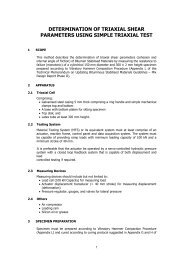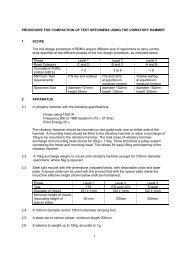Updating Bituminous Stabilized Materials Guidelines Mix Design Report Phase II
Moisture Sensitivity: Part II (Validation) - Asphalt Academy
Moisture Sensitivity: Part II (Validation) - Asphalt Academy
- No tags were found...
Create successful ePaper yourself
Turn your PDF publications into a flip-book with our unique Google optimized e-Paper software.
The disintegration of BSMs due to wet trafficking might occur due to quality of aggregates,<br />
cohesion and adhesion of aggregates-binder interface, void on the mixes, saturation level,<br />
temperature etc. The following subsection discusses findings on disintegration and ravelling<br />
results from MMLS3 testing.<br />
4.2 Disintegration and ravelling of BSMs<br />
Monitoring of the disintegration and ravelling of progressing MMLS3 test under wet trafficking<br />
consists of two types. Firstly, the surface disintegration, which monitored visually on spalled<br />
aggregates at intermittent times during trafficking. The spalling of aggregates can cause<br />
punchering of the wheel as well as vinite layer during trafficking. Secondly, cohesion loss or<br />
stiffness deterioration during wet trafficking is measured as cumulative ravelling using<br />
profilometer. The profilometer is placed transversely in seven (7) different positions along the<br />
beam i.e. on each specimen being tested. Data on cumulative ravelling is recorded and present<br />
in Tables shown in Section 3.1, and 3.2.<br />
The disintegration during MMLS3 test shows that, wet trafficking creates more damage in terms<br />
of cohesion loss or stiffness reduction than dry trafficking. The comparison made at the same<br />
number of load applications and testing temperature. No sign of significant initial densification<br />
occurred on BSMs. However, stiffness of the trafficked materials decreases as number of load<br />
application increases. This suggests that cohesion loss has occurred under traffic and the<br />
damage is aggravated by pore pressures in the presence of water.<br />
As an example of the ravelling results, Figure J.18 illustrates transverse ravelling profile<br />
measured on wet trafficking. Forty five thousand (45000) cumulative wheel loads were applied<br />
during this test.<br />
-2<br />
Ravelling-depth [mm]<br />
-0.5 0 50 100 150 200 250<br />
1<br />
2.5<br />
4<br />
5.5<br />
7<br />
8.5<br />
0<br />
200<br />
3000<br />
7000<br />
15000<br />
25000<br />
40000<br />
45000<br />
Profilometer position 4<br />
Figure J.18: Transverse ravelling measured during wet MMLS3 trafficking<br />
24












